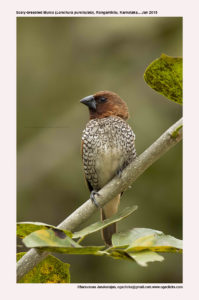
Scaly-breasted Munia Lonchura punctulata
Etymology:
- Lonchura : Greek word lonkhe – spear-head, lance; oura – {Spear like tail}
- Punctulata : Latin word punctulatus – spotted, dotted derived from punctulum –little spot
Vernacular names: Hindi: Teliamunia, Seenabaz, Pun: Teliamunia, Mirshikars: Sinewaz, Ben: Tileymunia, Ass: Toonisorai, Guj: Bharatitapkavalimunia, Taliyuntapushiyu, Mar: ThipkewaliManoli, Ori: Munia, Ta: Nellu-kuruvi, Tinna-kuruvi, Te: Kakkarajinuwayi, Chukkalajinuwayi, Mal: Chuttiatta, Kan: Chukkemunia, Sinh: Wee-kurulla
Scaly- breasted Muniaare small passerines birds. They are also called nutmeg mannikin or spice finch. Widely sold as a pet caged bird for its easy maintenance
Distribution in India: Widespread Resident in mainland India except for central and North West India
Description: Size of 10–12·5 cm; wt. of 12–16 g. The nominate race has deep reddish-brown on head to foreneck, darker on foreface and especially on chin and throat, slightly paler and duller on mantle, back and wings, with barely noticeable barring and often more noticeable pale shaft streaks. It is barred dark brown and whitish or yellowish on rump, dull golden-yellow to orange-brown barred darker on uppertail-coverts. The tail is similar to remiges in colour, but central rectrices have a strong golden tinge; breast and belly are white with black feather edges, giving scaled or scalloped appearance. The iris is dark brown to brownish-red, eyering is dark grey. The bill is blackish, lower mandible often paler bluish-grey at base; legs are grey. Both the sexes are alike. The juvenile is brownish-buff above, buff to whitish below, bill is black. Races differ mainly in colour of uppertail-coverts and colour and pattern of underparts, nominate the only one having black and white underparts with single black marking on edge of feathers, lower mandible entirely bluish-grey in some races:subundulata( Assam and North east India) is duller brown above than nominate, has uppertail-coverts as olive-yellow, underparts with narrow brown margin and central V-mark on each feather (‘double-scaled’).
Habitat: It is found in grassland with bushes, trees and scrub, scrubby mangroves, coastal landfill, rice fields, cultivated land, wasteland and gardens. It is found locally to 3000 m.
Food Habits: It is a grain/Seed eaters. It is found in Marshy areas with lots of Tall grass and Reeds. it feeds on the reed corns and any spilt grains and seeds.It also eats small berries in season. it is highly social and lives in large groups. Once in a group it alternates as “producers” of food and as “Scroungers”. The producers actively locate food source and then the scroungers also eat from it, in return the scroungers will alert the group in case of any predatory attack.
Breeding Habits : They breed in Monsoon Season from May -Sept.The courting male holds grass in bill, carries it, then drops it as he begins to sing and posture; sings, and swings head from side to side and pivots body, then perches upright, fluffs body feathers, and bobs as he stretches and bends legs. The nest is a large domed structure loosely woven from blades of grass, bamboo or other leaves with a side entrance and is placed in a tree or in crevices of a house. The nest opening is located to face downwind of the most frequent wind direction. The usual clutch is about four to six white eggs. Both sexes build the nest and incubate the eggs, which hatch in 10 to 16 days. The Chicks are Precocial (with open eyes and down feathers). They are fed insects initially for faster growth and water content. The chicks grow faster and leave the nest within 3 weeks. Within a year they are ready to breed.
When staying together, they sit side-by-side in close contact with each other. The outermost bird often jostles towards the center. Birds in a flock sometimes preen each other, with the soliciting bird usually showing its chin. The preening is usually limited to the face and neck